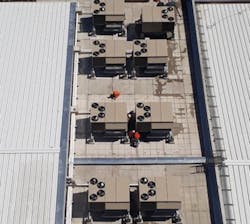Biden gives Defense Production Act authority to bring Energy Transition Supply Chain home
President Biden moved Monday to strengthen the domestic supply chain for lower and zero-emissions energy technologies.
Biden invoked the Defense Production Act to accelerate U.S.-based manufacturing in numerous energy transition categories. Those include solar power, transformers and electric grid components, heat pumps, insulation and electrolyzers, fuel cells and platinum group metals.
The moves, if fully realized, could lower energy costs, strengthen a domestic supply chain and achieve greater decarbonization of the nation’s energy output.
“President Biden has invoked the Defense Production Act so that the U.S. can take ownership of its clean energy independence,” said U.S. Secretary of Energy Jennifer M. Granholm. “For too long the nation’s clean energy supply chain has been over-reliant on foreign sources and adversarial nations. With the new DPA authority, DOE can help strengthen domestic solar, heat pump and grid manufacturing industries while fortifying America’s economic security and creating good-paying jobs, and lowering utility costs along the way.”
Concerns over the security of U.S. energy technologies, due to a global supply chain including China, date back several administrations. President Trump also put out an executive order to protect power grid equipment from cyberattack.
Electrolyzers and fuel cell technologies were included in the DPA invocation as the C&I sector turns its hopeful eyes toward hydrogen as a baseload and transportation resource. Hydrogen does not release carbon emissions when combusted, but it also is not mined naturally.
H2 is created for industrial purposes mainly through steam reforming of methane gas, a more carbon-intensive process, or by electrolyzers which separate the hydrogen and oxygen from water.
U.S. installed solar capacity has risen from nearly zero in 2000 to nearly four percent of national net generation, according to the federal Energy Information Administration. EIA projections forecast that will grow nearly 1 trillion kWh and 20 percent of the mix by 2050.
Many solar panel and module components, however, are made and shipped from Asia and other nations.
“We applaud President Biden’s thoughtful approach to addressing the current crisis of the paralyzed solar supply chain,” said Abigail Ross Hopper, president and CEO of the Solar Energy Industries Association. “The president is providing improved business certainty today while harnessing the power of the Defense Production Act for tomorrow. Today’s actions protect existing solar jobs, will lead to increased employment in the solar industry and foster a robust solar manufacturing base here at home.”
About the Author
Rod Walton, EnergyTech Managing Editor
Managing Editor
For EnergyTech editorial inquiries, please contact Managing Editor Rod Walton at [email protected].
Rod Walton has spent 17 years covering the energy industry as a newspaper and trade journalist. He formerly was energy writer and business editor at the Tulsa World. Later, he spent six years covering the electricity power sector for Pennwell and Clarion Events. He joined Endeavor and EnergyTech in November 2021.
Walton earned his Bachelors degree in journalism from the University of Oklahoma. His career stops include the Moore American, Bartlesville Examiner-Enterprise, Wagoner Tribune and Tulsa World.
EnergyTech is focused on the mission critical and large-scale energy users and their sustainability and resiliency goals. These include the commercial and industrial sectors, as well as the military, universities, data centers and microgrids. The C&I sectors together account for close to 30 percent of greenhouse gas emissions in the U.S.
He was named Managing Editor for Microgrid Knowledge and EnergyTech starting July 1, 2023
Many large-scale energy users such as Fortune 500 companies, and mission-critical users such as military bases, universities, healthcare facilities, public safety and data centers, shifting their energy priorities to reach net-zero carbon goals within the coming decades. These include plans for renewable energy power purchase agreements, but also on-site resiliency projects such as microgrids, combined heat and power, rooftop solar, energy storage, digitalization and building efficiency upgrades.

